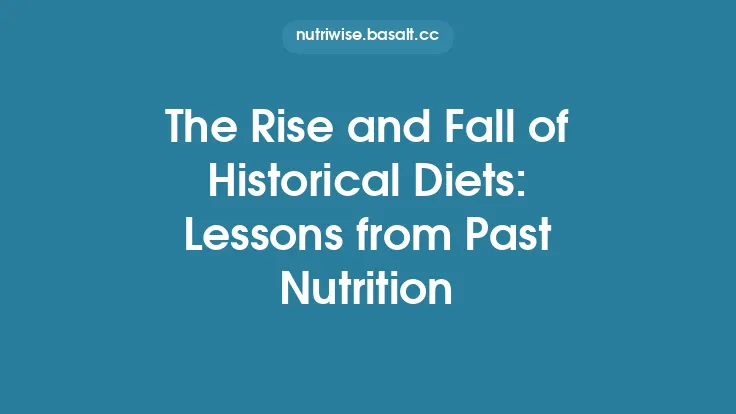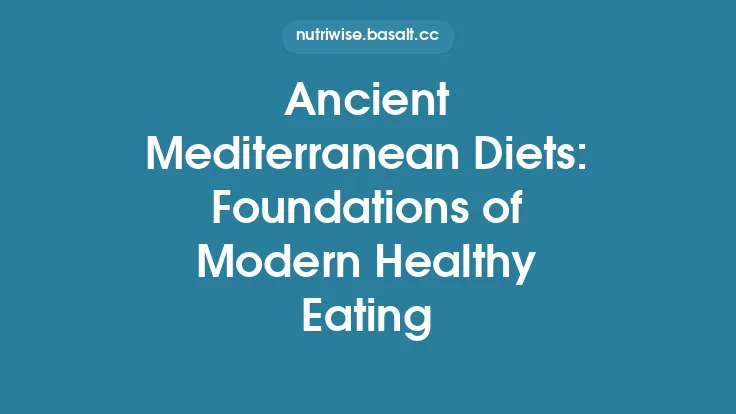Plant‑based eating has been a recurring thread in human history, weaving through the agricultural, cultural, and philosophical fabric of societies long before the modern labels of “vegetarian” or “vegan” emerged. From the fertile river valleys of the ancient Near East to the high plateaus of the Andes, peoples have crafted diets centered on grains, legumes, fruits, nuts, and vegetables, often out of necessity, reverence for the land, or ethical conviction. This overview traces the evolution of those plant‑centric traditions across continents, highlighting the agricultural innovations, culinary techniques, and sociocultural forces that shaped them.
Ancient Near Eastern Plant‑Based Traditions
The cradle of agriculture in the Fertile Crescent gave rise to some of the earliest systematic plant‑based diets. By the 9th millennium BCE, societies in present‑day Iraq, Syria, and Turkey cultivated wheat, barley, lentils, and chickpeas. These staples formed the backbone of daily meals, often prepared as simple porridges, flatbreads, or stews.
- Grain Domestication and Processing: Early milling techniques, such as stone grinding, allowed for the production of fine flours that could be mixed with water to create doughs. The resulting flatbreads—precursors to modern pita and naan—were portable, long‑lasting, and nutritionally dense, providing carbohydrates, protein, and modest amounts of B‑vitamins.
- Legume Integration: Lentils and chickpeas offered a complementary protein source, balancing the amino acid profile of cereals. Their ability to fix atmospheric nitrogen also enhanced soil fertility, reinforcing a sustainable agricultural loop.
- Vegetable and Fruit Supplements: Wild greens (e.g., purslane, amaranth) and cultivated vegetables like onions, garlic, and cucumbers added micronutrients and flavor complexity. Dates and figs, abundant in the region, supplied natural sugars, fiber, and antioxidants.
These plant‑rich meals were not merely sustenance; they were embedded in ritual and social practice. Communal feasting often featured large platters of flatbread and legume stews, symbolizing hospitality and shared abundance.
Classical Indian Vegetarianism
India presents one of the most enduring and philosophically grounded plant‑based traditions. By the Vedic period (c. 1500–500 BCE), a substantial portion of the population adhered to lacto‑vegetarian diets, influenced by religious doctrines (e.g., Ahimsa—non‑violence) and caste‑based dietary codes.
- Cereal Foundations: Rice in the south and wheat in the north served as staple grains. The development of sophisticated fermentation techniques produced idli, dosa, and chapati, enhancing digestibility and nutrient bioavailability.
- Legume Diversity: A wide array of pulses—dal (lentils), chana (chickpeas), urad (black gram), and moong (mung beans)—provided essential protein, iron, and folate. Their inclusion in daily meals helped offset the lack of animal‑derived nutrients.
- Spice and Herb Complexity: Turmeric, cumin, coriander, and fenugreek not only imparted flavor but also contributed anti‑inflammatory and antioxidant compounds, a practice later validated by modern phytochemical research.
- Dairy Integration: While strictly plant‑based, many Indian diets incorporated dairy (ghee, yogurt, paneer) as a source of calcium and vitamin B12, reflecting a flexible interpretation of vegetarianism that accommodated regional availability.
The Indian subcontinent’s climatic diversity fostered a mosaic of regional plant dishes, from the coconut‑laden curries of Kerala to the mustard‑seed‑spiced preparations of Bengal, each illustrating the adaptability of plant‑based nutrition to local ecosystems.
East Asian Plant‑Centric Cuisines
In East Asia, plant‑focused eating patterns emerged from both agricultural abundance and philosophical traditions such as Buddhism and Taoism, which emphasized harmony with nature.
- Rice and Millet Staples: The domestication of rice in the Yangtze River basin (c. 6000 BCE) and millet in the Yellow River region created carbohydrate foundations that supported dense populations. Steamed rice, congee, and millet porridge were daily staples.
- Soybean Innovations: Soybeans, introduced around 2000 BCE, gave rise to tofu, tempeh, soy sauce, and miso. Fermentation not only extended shelf life but also increased the bioavailability of essential amino acids, iron, and calcium.
- Vegetable Diversity: Leafy greens (bok choy, napa cabbage), root vegetables (daikon, taro), and seaweeds (nori, kombu) contributed vitamins A, C, K, iodine, and trace minerals. The practice of pickling (kimchi, tsukemono) preserved nutrients during winter months.
- Buddhist Monastic Diets: Monastic communities often adhered to strict vegetarianism, relying on seasonal vegetables, grains, and legumes. The concept of “shojin ryori” in Japan exemplifies a refined, plant‑only culinary art that balances taste, texture, and nutritional completeness.
These cuisines demonstrate how plant‑based foods can be elevated through fermentation, pickling, and meticulous preparation, creating complex flavor profiles without animal products.
Mesoamerican and Andean Plant‑Based Practices
The pre‑Columbian Americas cultivated a suite of nutrient‑dense plants that formed the core of indigenous diets.
- Three Sisters Agriculture: In Mesoamerica, the intercropping of maize, beans, and squash created a synergistic system. Maize supplied carbohydrates, beans contributed protein and lysine, while squash provided vitamins A and C, as well as a ground cover that reduced soil erosion.
- Maize Processing: Nixtamalization—soaking and cooking maize in alkaline water—released bound niacin, preventing pellagra, and improved calcium absorption. This technique produced masa, the dough for tortillas and tamales, underscoring the importance of food processing in nutritional adequacy.
- Andean Staples: In the highlands of present‑day Peru and Bolivia, quinoa, amaranth, and potatoes thrived. Quinoa’s complete amino acid profile and high mineral content (magnesium, phosphorus) made it a superior grain alternative. Potatoes, rich in vitamin C and potassium, were cultivated in diverse varieties, ensuring food security across microclimates.
- Legume and Seed Utilization: Lima beans, lupins, and chia seeds added protein, omega‑3 fatty acids, and dietary fiber, illustrating a sophisticated use of plant resources beyond staple grains.
These systems highlight how indigenous knowledge optimized plant diversity to meet macro‑ and micronutrient needs, often without reliance on animal products.
African Indigenous Plant Diets
Across the African continent, plant‑based eating patterns were shaped by varied climates—from the Sahelian savannas to the tropical rainforests.
- Sorghum and Millet in the Sahel: Drought‑tolerant cereals such as sorghum and millet formed the basis of porridges (e.g., “tuwo”) and flatbreads. Fermentation of these grains produced sourdough-like breads that enhanced B‑vitamin content and reduced antinutrients.
- Root Crops in the Tropics: Cassava, yams, and sweet potatoes provided carbohydrate energy and vitamin A precursors (β‑carotene). Proper processing (e.g., soaking, fermenting) mitigated cyanogenic glycosides in cassava, ensuring safety.
- Legume Integration: Cowpeas, pigeon peas, and groundnuts (peanuts) supplied protein, iron, and healthy fats. Groundnut sauces, often combined with leafy greens, created nutritionally balanced meals.
- Leafy Greens and Wild Greens: Indigenous greens such as amaranth leaves, moringa, and baobab leaves offered high levels of calcium, iron, and vitamin C. Their regular consumption helped offset mineral deficiencies common in cereal‑dominant diets.
In many African societies, communal meals centered around a shared “stew” or “soup” served over a starch base, reinforcing social cohesion while delivering a plant‑rich nutrient profile.
Medieval European Plant‑Based Foodways
While medieval Europe is often associated with meat‑heavy feasts among the aristocracy, the majority of the population subsisted on plant‑centric fare.
- Cereal Dominance: Rye, barley, and oats were staple grains for the lower classes, used to make pottage—a thick stew of grains, legumes, and seasonal vegetables. Bread, typically made from coarse whole‑grain flour, provided the bulk of caloric intake.
- Legume Utilization: Peas, beans, and lentils were cultivated in rotation with cereals, enriching soil nitrogen and offering a protein source. Dried legumes stored well through winter, ensuring year‑round availability.
- Foraged Greens: Wild herbs (nettles, sorrel) and cultivated greens (cabbage, kale) were abundant, supplying vitamins A and K. The practice of “herb gardens” around monasteries and manor houses facilitated continuous harvests.
- Monastic Influence: Many monastic orders adopted vegetarian or semi‑vegetarian diets, emphasizing simplicity and self‑sufficiency. The Cistercian order, for instance, promoted the cultivation of beans and legumes as a means of supporting the community without reliance on animal husbandry.
These plant‑based practices were driven by economic necessity, seasonal constraints, and religious ideals, illustrating a complex interplay between diet and societal structure.
Colonial and Early Modern Plant‑Based Influences
The age of exploration and colonization introduced new plant foods across continents, reshaping dietary landscapes without necessarily increasing animal consumption.
- Crop Exchanges: The Columbian Exchange brought maize, potatoes, and tomatoes to Europe, Africa, and Asia, while Old World grains like wheat and rice spread to the New World. These introductions expanded the variety of plant foods available to diverse populations.
- Plant‑Based Trade Commodities: Spices (pepper, cinnamon), sugarcane, and tea became global commodities, often consumed with plant‑based preparations (e.g., tea with plant‑derived sweeteners).
- Urban Plant‑Based Street Foods: In burgeoning colonial cities, street vendors sold fried dough (e.g., beignets), roasted corn, and bean‑based snacks, providing affordable, plant‑rich options for laborers.
The period saw a gradual diversification of plant foods, laying groundwork for later health movements that would champion plant‑centric nutrition.
20th‑Century Vegetarian and Vegan Movements
The modern era witnessed organized advocacy for plant‑based diets, propelled by scientific, ethical, and environmental arguments.
- Early Vegetarian Societies: Founded in the late 19th and early 20th centuries, these societies promoted meat‑free eating for health and moral reasons. They disseminated cookbooks, organized lectures, and established vegetarian restaurants, normalizing plant‑based meals in urban settings.
- Nutritional Research Milestones: Mid‑century studies identified essential nutrients—vitamin B12, iron, omega‑3 fatty acids—and explored plant sources or supplementation strategies. The development of fortified plant milks and soy‑based meat analogues addressed previously perceived deficiencies.
- Rise of Veganism: In the 1940s, the term “vegan” emerged to denote a stricter avoidance of all animal products. Early vegan pioneers experimented with soy protein isolates, leading to the creation of textured vegetable protein (TVP) and later, plant‑based burgers.
- Policy and Public Health: Some governments began recognizing plant‑based diets in dietary guidelines, emphasizing increased fruit, vegetable, and legume consumption for chronic disease prevention.
These movements transformed plant‑based eating from a niche practice into a mainstream dietary option, supported by a growing body of scientific evidence.
Contemporary Global Plant‑Based Trends
Today, plant‑based diets are experiencing unprecedented global adoption, driven by health research, sustainability concerns, and culinary innovation.
- Diverse Protein Sources: Beyond soy, peas, lentils, and chickpeas, novel proteins such as mycoprotein (derived from fungi) and algae‑based powders are entering the market, offering complete amino acid profiles and low environmental footprints.
- Food Technology Advances: Precision fermentation enables the production of dairy‑free cheeses and egg‑free emulsifiers without animal inputs, expanding the sensory range of plant‑based foods.
- Cultural Fusion: Chefs worldwide are integrating traditional plant‑based ingredients—like Ethiopian teff injera, Filipino banana blossoms, or West African fonio—into contemporary dishes, fostering cross‑cultural appreciation of plant nutrition.
- Nutrient Optimization: Modern formulations often include biofortified grains (e.g., iron‑rich beans), fortified plant milks (with calcium, vitamin D, B12), and targeted supplementation strategies to ensure comprehensive micronutrient coverage.
The current wave reflects a synthesis of historical wisdom and cutting‑edge science, illustrating that plant‑based diets have been, and continue to be, a resilient and adaptable component of human nutrition.
Across millennia, plant‑based diets have demonstrated remarkable flexibility, meeting the caloric, protein, and micronutrient demands of diverse peoples while aligning with cultural values and ecological realities. By examining the agricultural innovations, culinary techniques, and societal forces that have shaped these diets, we gain insight into a nutritional paradigm that is both ancient and ever‑relevant—a testament to humanity’s enduring relationship with the plant kingdom.





